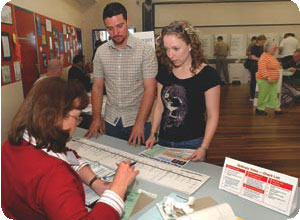2004 Federal Election
In this Section:
The Prime Minister, Mr John Howard, announced on Sunday 29 August 2004 that an election for the House of Representatives and half the Senate was to be held on Saturday, 9 October 2004. In the half Senate election, eligible electors in each State were choosing six Senators to serve a six year term. Electors in the two Territories were each voting for two Senators to serve a maximum three year term. This meant a total of 40 Senate vacancies were to be contested.
The 2004 federal election was also an election for the 150 vacancies in the House of Representatives. Electors in each of the 150 divisions were electing one Member to the House of Representatives to serve a maximum term of three years.
Issue of the writs

Election day must be a Saturday, at least 33 days after the issue of the writs.
The writs for the 2004 federal election were issued on Tuesday 31 August. The issue of the writ officially triggered the election process.
Senate: Eight separate writs were issued, one for the election of Senators in each State and Territory. The writ for the Senate election was issued by the Governor of each State to their respective State AEO; and the writs for the Senate election in the two Territories were issued by the Governor-General to each Territory’s AEO.
House of Representatives: Eight separate writs were issued for the House of Representatives election-one for all divisions in each State and Territory. The writs for the House of Representatives elections were issued by the Governor-General to the Electoral Commissioner, who advised each of the 150 DROs of the election.
2004 federal election timetable
An election timetable is determined by the Constitution and the Act. The Act sets a minimum election period of 33 days and a maximum period of 58 days from the issue of the writs to election day. The actual dates for the 2004 federal election are presented in the right hand column below.
| Min. and Max. Period | 2004 Federal Election Date | |
|---|---|---|
| Expiry or dissolution of Parliament Parliament is dissolved and the Prime Minister announces the intention to hold an election. |
||
| Issue of Writs A writ commands an electoral officer to hold an election and contains dates for the close of rolls, close of nominations, election day and the return of the writ. (Constitution s.12, 32) (the Act s.151) |
0-10 days from dissolution of House of Representatives | Tuesday 31 August 2004 |
| Close of rolls Electors have until 8pm, seven days after the writs are issued to enrol or update their details on the Commonwealth Electoral Roll. (the Act s.155) |
7-17 days | Tuesday 7 September 2004 |
| Close of nominations Candidates must nominate by 12 noon on the date specified on the writs as close of nominations, 10 to 27 days after issue of the writ. (the Act s.156) |
10-37 days | Thursday 16 September 2004 |
| Declaration of nominations The public announcement of nominations received by 12 noon, followed by a draw for positions on the ballot paper, 24 hours after the close of nominations. (the Act s.176) |
11-38 days | Friday 17 September 2004 |
| Election day The day on which the majority of electors cast their vote at a polling place. It must be a Saturday and at least 33 days after the issue of the writs. (the Act s.157) |
33-68 days | Saturday 9 October 2004 |
| Return of writs
Senate: After the Senate polls are declared, the Australian Electoral Officer for each State and Territory returns the writ, endorsed with the names of the successful candidates, to the State Governor (or Governor-General in the case of the Territories). House of Representatives: For the House of Representatives, the Electoral Commissioner endorses on the writ the name of each candidate elected for each division and returns the writs to the Governor-General. Writs must be returned within 100 days of their issue. (the Act s.159) |
110 days | Thursday 11 November 2004 |
| Meeting of Parliament The new Parliament must meet within 30 days of the day appointed for the return of the writs. (Constitution s.5) |
140 days | Tuesday 16 November 2004 |
